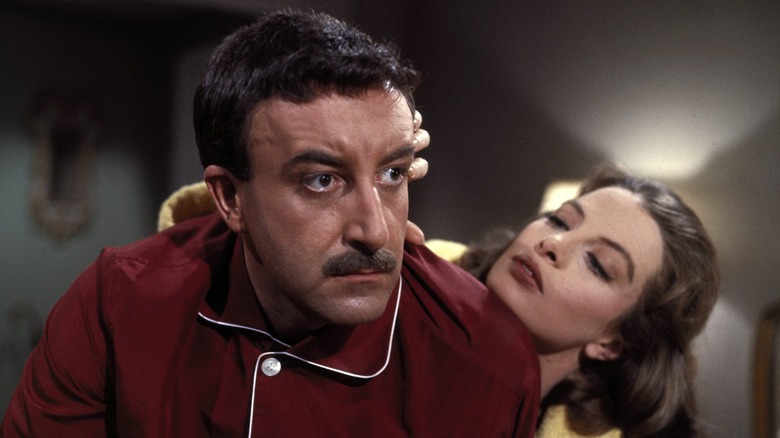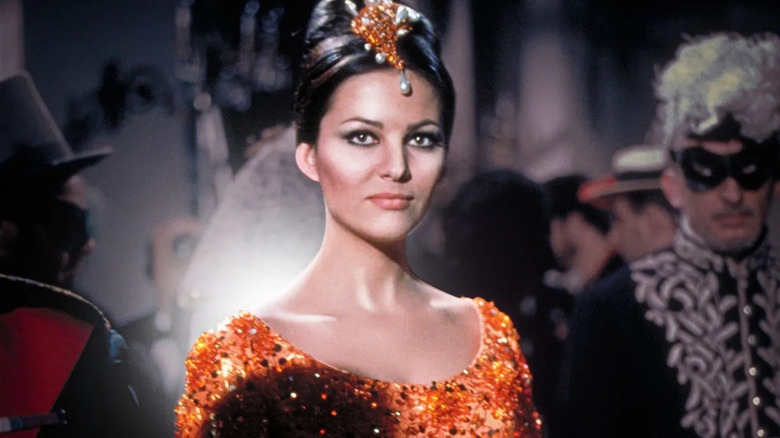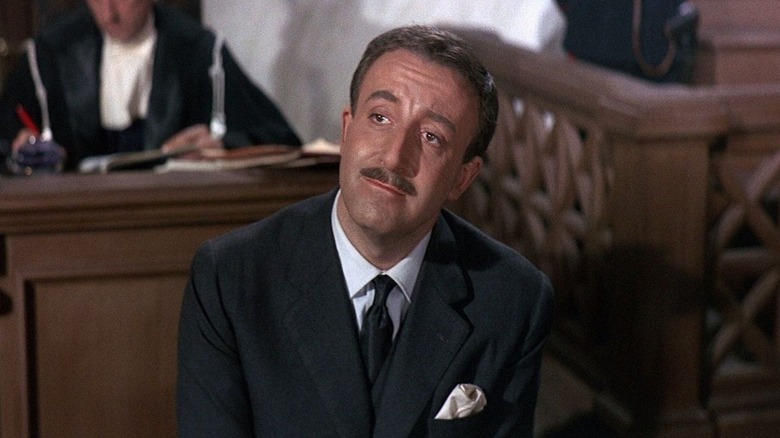Peter Sellers Changed The 'Entire Concept' Of The Pink Panther's Jacques Clouseau
The "Pink Panther" film series reached its peak silliness in the 1970s and was all the better for it. Come "The Pink Panther Strikes Again," Blake Edwards and Peter Sellers had dropped the usual business of framing Inspector Clouseau's bumbling antics with a wider crime caper and just focused on him and his arch-nemesis, former Chief Inspector Charles Dreyfus (Herbert Lom). Dreyfus, having had it up to here after years of Clouseau's ineptitude, builds a vanishing ray and threatens the world with annihilation if the clueless detective isn't assassinated.
You can see the jokes coming from a mile away, but it hardly matters when you have a comic talent like Sellers delivering the gags. This is the period when all the elements of Clouseau that literally had me rolling on the floor laughing as a kid were cranked up to epic proportions; his penchant for zany disguises; the apartment-trashing fights with his manservant Cato (Burt Kwouk); his outrageously comedic French accent; and the pratfalls that turned even the most innocuous scenario into an escalating scene of destruction.
Sellers' Clouseau (let's not get into Alan Arkin, Roger Moore, or Steve Martin) is like Stan Laurel and Oliver Hardy rolled into one; he has a Stan side, for whom the most basic daily task (walking through a door, carrying groceries, etc.) is fraught with disaster; then he has the Ollie side, an arrogant buffoon whose pomposity is always punctured by the former.
Clouseau grew very broad over the years following the original "The Pink Panther," when the detective was still very accident-prone but resembled a normal human being who might actually be able to get along in everyday society. Yet even that relatively reserved Clouseau was far more slapstick than the way he was initially conceived.
So what happens in The Pink Panther again?
If "The Pink Panther Strikes Again" played like a daft Bond spoof, the original film was far closer to the leisurely crime capers that were all the rage in the 1950s and '60s. Peter Sellers only received second billing to David Niven, who initially thought the film could set up a light-hearted franchise for him in the vein of "The Thin Man" movies (via Best Movies by Farr).
Niven plays Sir Charles Lytton, a suave ladies' man by day, and a gentleman jewel thief known as "The Phantom" by night. He has become famous for leaving his calling card, a white glove embroidered with the letter "P," at the scene of his crimes. Lytton's next target is the world's largest diamond, known as the Pink Panther for a flaw that resembles a leaping jungle cat. The priceless gem was given to Princess Dala (Claudia Cardinale) by her father, the Maharajah of the fictional Lugash, as a gift when she was a child. Now living in exile, the new government of her country wants to declare the stone property of the people.
Princess Dala just happens to be staying at the same luxury Italian ski resort as Sir Charles, who wastes no time trying to sweet-talk her into revealing the location of the diamond. Also on vacation is Inspector Jacques Clouseau (Peter Sellers), who has been tracking The Phantom for many years. Little does he know that his wife Simone (Capucine) is working as a fence for Sir Charles and is also having an affair with him. To complicate matters further, the jewel thief's cocksure nephew George (Robert Wagner) arrives and sets his sights on seducing Simone. Can Clouseau crack the case before the Phantom has his wicked way and steals the diamond?
Sellers puts his unique stamp on the Clouseau character
The part of Inspector Clouseau was originally intended for Peter Ustinov, who pulled out of the project last minute. A desperate search for a new Clouseau concluded when Blake Edwards found Peter Sellers, who was seeking to make a move into American movies after the death of his father. Edwards said (via Best Movies by Farr):
"For years I'd been getting bits of what I wanted into films, as writer or director ... but I had never had an area in which to exploit my ideas to the full. Then along came Peter, a walking storehouse of madness, a ham with an almost surrealist approach to the insanity of things, and we found an immediate affinity."
According to Edwards, the key to tapping into Sellers' innate comic abilities was changing "the entire concept of the [Closeau] character," who was originally imagined as a "straight, sober-sided, dignified cop" (via AFI). Sellers had other ideas: In his hands, the detective would become a "funny, pathetic, bumbling, lovable" guy.
Compared to the later films, Sellers' performance is low-key, although he still can't help knocking stuff over in just about every scene. He's also far more sympathetic than the deluded clown that he would become. It's easy to feel sorry for him as his wife keeps turning him down before sneaking off to her lover, and he looks genuinely crestfallen when the jewel theft is pinned on him at the end.
Nevertheless, that tweak of Clouseau's personality set the tone for the entire series and elevated the secondary role to the star of the show. He would become far more cartoonish as the films went on but one thing is for sure: Those initial changes Sellers made were essential to creating his best-loved character.


